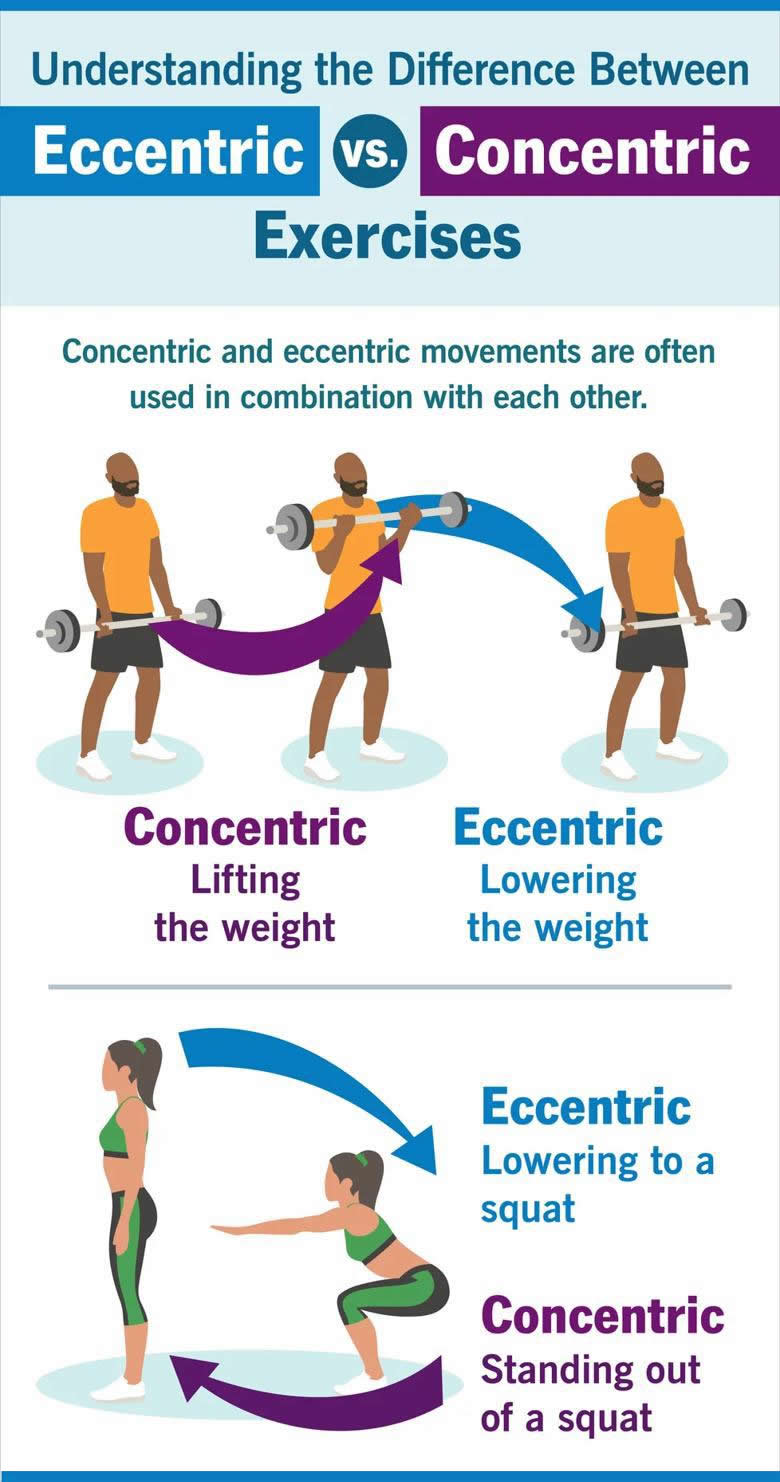Understanding the Difference Between Eccentric and Concentric Exercises
Eccentric is slow and steady, while concentric is fast and controlled

Whether you’re lifting weights or popping a squat, moving with intention is important for any exercise or strength training routine. But do you focus more on concentric actions — when you’re lifting weight or standing up from a squat? Or do you put more emphasis on eccentric actions — like letting the weight down and squatting to the ground?
Sports medicine specialist Michael Dakkak, DO, says both types of movements are key to building strength and muscle mass. Dr. Dakkak explains their differences and how to use eccentric and concentric together in your training.
Eccentric vs. concentric exercises
Eccentric exercise and concentric exercise are two different sides of the same coin. They’re often used in combination with each other, but both halves emphasize different muscle movements and speed.

What is eccentric training?
Eccentric training is defined by the elongation or lengthening of muscles. On the surface, it sounds like you’re immediately relaxing from a flexed position — but this isn’t completely accurate. Eccentric movements are meant to be slow and controlled. For example, you’re slowly resisting gravity and controlling the speed at which you lower a weight. Other examples include:
- Slowly dropping down into a squatting position.
- Slowly lowering yourself to the floor from an extended push-up position.
- Slowly lowering down into the lunge position.
“Often, tendon training gets overlooked when we’re focused on muscle strengthening because all of our attention gets stuck on the lift instead of the letdown,” notes Dr. Dakkak. “Eccentric training is just as important for building strength and endurance, and we should approach resistance with the same level of control as lifting.”
Eccentric benefits
When you’re focused on resistance, lowering weight and lengthening your muscles, you benefit from:
- Increased muscle control
- Increased muscle fiber
- Stronger tendons
- Improved ability to withstand higher weight
- More microtears in muscle, leading to muscle growth and improved endurance
- Lower rates of injury
- Faster muscle recovery
“We know eccentric training is probably one of the most beneficial things to strengthen your tendons,” says Dr. Dakkak. “During eccentric exercises, you’re allowing your muscles to actually generate almost one-and-a-half times more force by activating slow-twitch muscle fibers (which use energy slowly). Those movements allow your body to withstand higher weight for longer periods of time and improve your endurance.”
What are concentric movements?
Concentric movements are defined as the contracting or shortening of muscles. Although these movements tend to be short-lived and explosive, they’re meant to be tightly controlled. They’re often the part of the exercise that most people focus on. It’s the lifting of a bicep curl, the moment you push yourself up from a push-up position and the exploding rise to stand up from a squat.
“You want to move with purpose, no matter if the weight is light or heavy,” advises Dr. Dakkak. “You want to engage that explosive movement through the muscle like you’re really trying to flex through your entire range of motion. Keep those muscle fibers as tight as possible until you reach the point where your joint can’t move any further in a specific direction. Then, you move into your eccentric phase.”
Concentric benefits
By focusing on controlled, explosive, fast-acting concentric movements, you benefit from:
- Greater functional strength
- Increased power
- Increased muscle mass
- Increased activation of muscle fibers
- Improved athletic performance
- Long-term muscle activation
“Through fast, controlled movement, you activate more of your fast-twitch muscle fibers that are designed for power and speed,” he adds.
Eccentric and concentric together
The eccentric and concentric phases are separated by an isometric phase — the part of the exercise where you hold your position before moving into the next phase. So, when you’re weightlifting or doing any exercise, you want to really focus on controlling your eccentric movements, holding that position, and then forcefully pushing through the concentric phase for each and every repetition.
“No matter what level of fitness you’re at, whether you’re a world-class athlete or someone who’s just starting to become active, it’s really important to approach each of these phases with intention,” recommends Dr. Dakkak.
“Starting off with bodyweight exercises is a great place to begin, and if bodyweight exercises seem too much, you can use a machine to help so you’re not pulling your full body weight.”
To learn the correct way to do these movements, Dr. Dakkak suggests starting with these bodyweight exercises:
- For squats: From a standing position, slowly lower yourself to the ground (eccentric), stopping where it’s comfortable. Hold for three to five seconds, then explode quickly up to the starting position (concentric).
- For push-ups: Placing your palms on the ground while on all fours, take three to five seconds to slowly lower yourself to the ground (eccentric). Pause, before explosively pushing yourself back up in one to two seconds (concentric).
- For lunges: For a standard lunge, take three to five seconds to slowly lower your weight to the ground (eccentric). After reaching the bottom, push through your front heel to rise up in one to two seconds (concentric).
- For pull-ups:Holding onto the bar above you, pull yourself up quickly in one to two seconds (concentric). Then, slowly lower yourself back down in three to five seconds to emphasize control (eccentric).
For an increased challenge, you can progressively add weight, increase the speed of your concentric phases or reduce the amount of rest between sets and reps. The process of adjusting these different variables to maximize your experience is called periodization.
“The best athletes in the world don’t just focus on their strength; they focus on how they control their strength,” clarifies Dr. Dakkak. “It’s not just about being strong; it’s about being able to remain controlled through all phases of movement.”